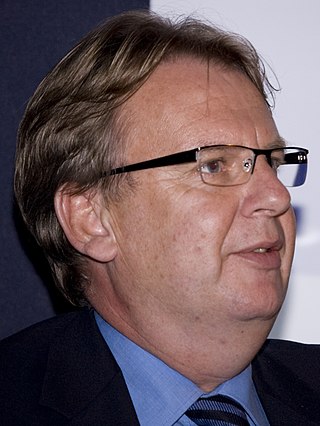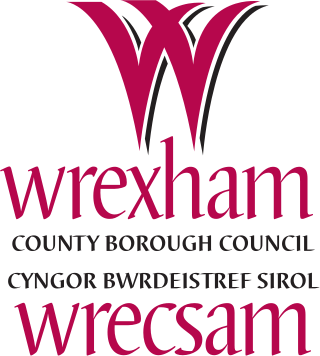Plaid Cymru is a centre-left to left-wing, Welsh nationalist political party in Wales, committed to Welsh independence from the United Kingdom. It campaigns on a platform of social democracy and civic nationalism. The party is a strong supporter of the European Union and is a member of the European Free Alliance (EFA). The party holds 4 of 32 Welsh seats in the UK Parliament, 12 of 60 seats in the Senedd, and 202 of 1,231 principal local authority councillors. Plaid was formed in 1925 under the name Plaid Genedlaethol Cymru and Gwynfor Evans won the first Westminster seat for the party at the 1966 Carmarthen by-election.

Powys is a county and preserved county in Wales. It borders Gwynedd, Denbighshire, and Wrexham to the north; the English ceremonial counties of Shropshire and Herefordshire to the east; Monmouthshire, Blaenau Gwent, Merthyr Tydfil, Caerphilly, Rhondda Cynon Taf, and Neath Port Talbot to the south; and Carmarthenshire and Ceredigion to the west. The largest settlement is Newtown, and the administrative centre is Llandrindod Wells.

The Senedd, officially known as the Welsh Parliament in English and Senedd Cymru in Welsh, is the devolved, unicameral legislature of Wales. A democratically elected body, it makes laws for Wales, agrees to certain taxes, and scrutinises the Welsh Government. It is a bilingual institution, with both Welsh and English being the official languages of its business. From its creation in May 1999 until May 2020, the Senedd was officially known as the National Assembly for Wales and was often simply called the Welsh Assembly.

Newtown is a town in Powys, Wales. It lies on the River Severn in the community of Newtown and Llanllwchaiarn, within the historic boundaries of Montgomeryshire. It was designated a new town in 1967 and saw population growth as firms settled, changing its market town character. Its 2001 population of 10,780 rose to 11,357 in the 2011 census, and rose again to 11,362 in the 2021 census.

Wrexham County Borough is a county borough, with city status, in the north-east of Wales. It borders the English ceremonial counties of Cheshire and Shropshire to the east and south-east respectively along the England–Wales border, Powys to the south-west, Denbighshire to the west and Flintshire to the north-west. The city of Wrexham is the administrative centre. The county borough is part of the preserved county of Clwyd.

Rhodri Glyn Thomas is a Welsh politician. He was the Plaid Cymru National Assembly for Wales Member for Carmarthen East and Dinefwr from 1999 to 2016, when he did not re-stand for election. Following his retirement from the Assembly he was appointed President of the National Library of Wales.

Wrexham County Borough Council is the governing body for Wrexham County Borough, a principal area with city status in north Wales, covering Wrexham and the surrounding area.

Alun Ffred Jones is a Welsh politician and member of Plaid Cymru and former television producer, writer and director. Jones was the National Assembly for Wales Member for Caernarfon 2003–07 and for the newly created Arfon constituency from 2007 until he stood down in 2016. He served as Minister for Heritage between 2008 and 2011 as part of the One Wales Government. In 2008 he made history by being the first UK representative to speak in the Welsh language at a meeting of the European Union. He was Chairman of Plaid Cymru from October 2019 until he resigned in July 2022.

Welsh independence is the political movement advocating for Wales to become a sovereign state, independent from the United Kingdom.

North East Wales is an area or region of Wales, commonly defined as a grouping of the principal areas of Denbighshire, Flintshire, and Wrexham County Borough in the north-east of the country. These principal areas comprise most of the former administrative county of Clwyd. It is bordered by Conwy, and Gwynedd, in North West Wales to the west, Powys, in Mid Wales to the south, the English counties of Cheshire, and Shropshire to the east, and the Irish Sea, and Dee estuary to the north. It is the more urban, densely populated, and industrial part of the north Wales geographic region, centred on the city of Wrexham and the towns of Rhyl and Prestatyn, and the conurbation of Deeside. The region's close links with North West England in general and Merseyside in particular are crucial to the region's economy. The Clwydian Range and Dee Valley Area of Outstanding Natural Beauty is located in the region. Other attractions include historical buildings such as Chirk Castle, and Erddig in Wrexham, valley towns such as Corwen and Llangollen, and the Pontcysyllte Aqueduct and Canal World Heritage Site.
The North Wales Metro is a rail and bus transport improvement programme in north Wales. Styled as a "Metro", it is conceptually a multi-modal system with a combination of bus, heavy rail, and light rail services. It was initially focused on linking major settlements and employment areas of the north-east of Wales with the North West of England, with its hubs located in Wrexham, Chester and Deeside, although the programme has since expanded, with proposals extending to Anglesey in the north-west of Wales. The existing Borderlands line forms a core rail component of the network, where projects to increase connections, integrated access, and service frequency between Wrexham, Deeside and Liverpool are centred upon. The proposals were put forward in 2016 as is part of Welsh Labour's plan for north Wales. Labour has pledged to open the system by 2035. The proposals were included in the 2018 Wales & Borders franchise contest. It is the second of the three regional metros proposed by the Welsh Government to go ahead, after the South Wales Metro, and before the Swansea Bay and West Wales Metro. The project is described to be in its initial phases.
Wrexham North is a proposed railway station on the Shrewsbury–Chester line, situated between Rossett and Wrexham, in Wrexham County Borough, Wales. As of January 2022, there is no definitive site for the proposed station, with proposals including: the former Rossett railway station or a station near Pandy, Wrexham and Gresford. Unless construction of the station south of Rossett coincides with the full or partial dualling of the currently single track railway line towards Stansty, Wrexham North may be a single platform station or if situated at Rossett Junction be linked by a single track southwards to Wrexham.

The 2022 Wrexham County Borough Council election took place on 5 May 2022 to elect 56 members to Wrexham County Borough Council, the principal council of Wrexham County Borough, Wales. On the same day, elections were held to the other 21 local authorities, and community councils in Wales as part of the 2022 Welsh local elections. The previous Wrexham County Borough all-council election took place in May 2017 and future elections will take place every five years, with the next scheduled for 2027.
Wrexham South is a proposed railway station on the Shrewsbury–Chester line, situated between Chirk and Wrexham, in Wrexham County Borough, Wales. As of January 2022, there is no definitive site for the proposed station, with proposals for the station to be located either near Johnstown or at Rhosymedre on the former Rhosymedre Halt railway station. If the latter location is decided, Ruabon would be the station closest to the south of Wrexham.

County Buildings is a Grade II listed building in Wrexham, Wrexham County Borough, Wales. It currently houses the Wrexham County Borough Museum and Wrexham Archives. By 2026, the building would become one museum, dedicated to both Wrexham and Welsh football heritage. The building is located between Saint Mark's Road and Regent Street in the city centre and Offa, bounded by Wrexham Cathedral to the west.

Wrexham County Borough Museum is a local history museum in Wrexham, Wrexham County Borough, Wales. It is located within County Buildings, alongside the Wrexham Archives. The building is located on Regent Street, in the city centre.

Tŷ Pawb is an arts centre in Wrexham, Wales. It serves as a venue for arts, cultural and community events, as well as being a market and art gallery. A redevelopment of the former Wrexham People's Market between Chester Street and Market Street in Wrexham city centre, the community centre opened on 2 April 2018. It provides exhibitions, a gallery, a food court, small stage concerts and live events, as well as a market space for local traders and the relocation of Oriel Wrecsam. A multi-storey car park is located on top of Tŷ Pawb, on the building's upper floors.
A North–South Wales railway, also known as Traws Link Cymru is a proposed rail service line that would link North and South Wales via a western rail line from Swansea to Bangor. This includes re-opening the Carmarthen–Aberystwyth and the Bangor–Afon Wen line.
A national park has been proposed to replace the Clwydian Range and Dee Valley AONB in the north-east of Wales. Proposals for the then Clwydian Range AONB, established in 1985, to become a national park were first raised in 2010. In the 2021 Senedd election, Welsh Labour committed to establishing Wales' fourth national park in the north-east. Following Labour forming the next Welsh Government, the government commissioned Natural Resources Wales to develop proposals for the new national park.
The National Contemporary Art Gallery for Wales is a proposed branded network of art galleries distributing Wales' existing contemporary art collection. It is being developed by a partnership of Amgueddfa Cymru – Museum Wales, the Arts Council of Wales, the Welsh Government and the National Library of Wales. The proposal formed part of the 2021 Welsh Labour–Plaid Cymru agreement.















